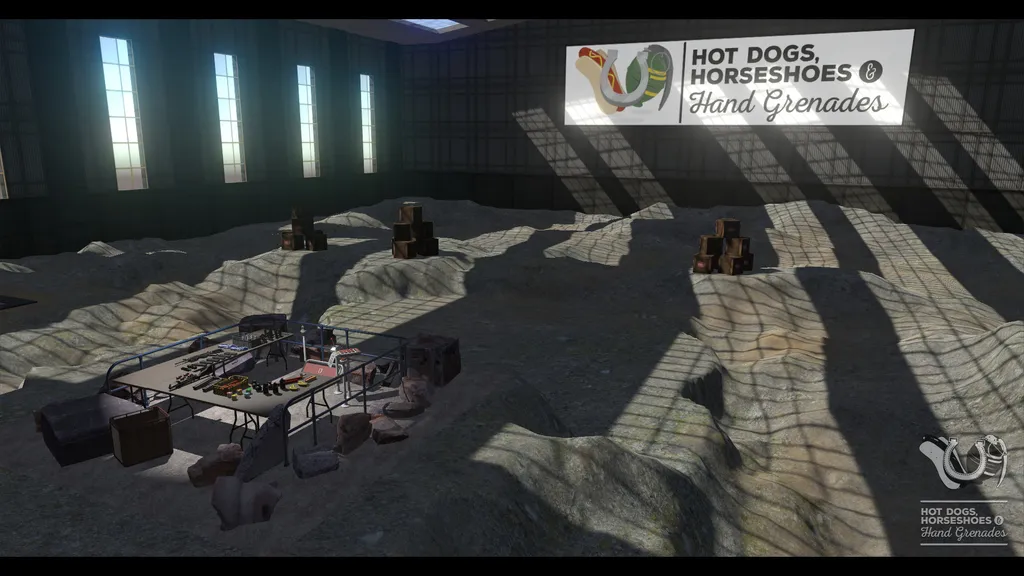In February 2016, Anton Hand emailed Valve’s Chet Faliszek with details about some of his previous work with Unity and experiments in VR.
Hand was one of the earliest backers of the Oculus Rift on Kickstarter, and earlier at the University of Buffalo, he spent time working with a CAVE VR system. One of the experiments he said he built back then was a shooter level with pistol, shotgun and a few other guns.
Faliszek sent Hand a Vive Pre for free, as he had done many other times for developers looking to explore VR. Using that previous knowledge and experience, after two days with the headset, Hand posted a video to YouTube showing the fundamentals of loading a gun and shooting targets in VR.
When the Vive launched two months later, RUST LTD. put the first version of Hot Dogs, Horseshoes & Hand Grenades (H3VR) up on Valve’s Steam for $19.99. It has never been on sale and never been bundled with headsets, so when Hand tells me they’ve sold more than 95,000 copies of the game through Steam — the math is neat. At the current rate they’ll clear 100,000 copies not long after the game turns two years old. That’s roughly $1 million in gross sales per year, with Valve taking an estimated 30 percent cut.
The core team at RUST LTD. is Hand (CTO) with Lucas Miller (CEO), Luke Noonan (President), Adam Sulzdorf-Liszkiewicz (COO) working with a “network of friends, colleagues, contractors who have worked with us on past contract work and projects,” according to Hand. The gun models in the game come from a variety of sources, including licensed, commissioned and donated.
“We’ve had people just show up the past two years and just straight up donate to us AAA-quality firearm models,” Hand wrote. “Because they want them in the game, and functional so they can play with them.”
The path H3VR took to selling 100,000 copies of a VR game priced at $20 is remarkable for the absence of traditional marketing. It is unavailable on what is arguably the largest VR platform — PSVR — and they didn’t buy ads or write press releases for its PC-based VR game launch. Instead, the developers focused on constant experimentation in VR and they put that in front of a community drawn in through the Steam page and forum, or Hand’s constant videos on YouTube. If you take a tour through his YouTube channel, it records the complete evolution of the game from its origins in that first video embedded above. There’s also a subreddit dedicated to the game and an unofficial Discord group, each of which were started by members of the community.
This constant show of progress and experimentation combined with obsessive 24/7 responsiveness to feedback — sometimes seeing a request and posting an update answering it hours later — has drawn in a supportive community. Even after two years H3VR remains in Early Access, with the latest “Update 52” marking their progress over that time as they transitioned from updates weekly to every two weeks. H3VR carries an “overwhelmingly positive” rating on Steam with more than 1,500 reviews.
Its features are listed as specifically for the roomscale HTC Vive with:
- Games and experiments across various genres and degrees of structure.
- Multiple shooting and demolitions ranges from realist to fantastical.
- Timed challenges with global leaderboards.
- Almost 150 accurate simulations of historical, modern and futuristic weapons.
- Mini-games and challenges that are great for Hot-Headset play with friends!
- A surreal irreverent vision of the future United States of ‘Murica.
- And whatever other madness we see fit to add!
I asked Hand how they reached their sales milestone and built their community, and he believes it was a combination of the weekly developer updates followed by streamers who discovered the game and then brought in their audiences by showing the game on their channels.
“Its been about letting the community in, letting them see all the dirty corners, rough edges, trying to pull in their desires and suggestions, and being human to them, instead of holding them at arms length,” he wrote. “So the genre breadth of [H3VR’s] scenes can be seen as a set of experiments…we start with a fairly realistic simulation of a firearm, designed to be accurate instead of make you feel like super hero, and then smash that up with a bunch of game genres and see what works, what doesn’t, what’s fun, what isn’t, and do ‘live’ research on a huge audience. The thing that binds the game together is the detailed simulation, and design constraint that everything is as physical as the engine can handle.”


























